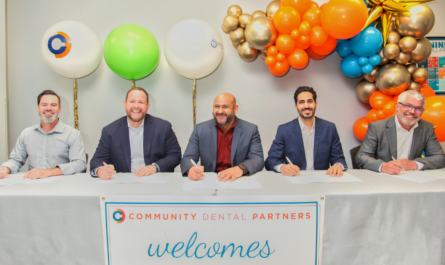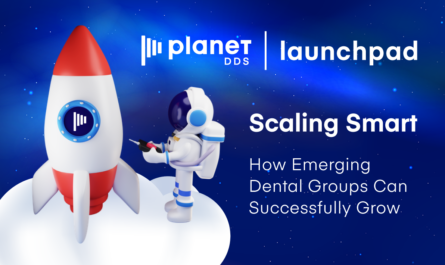How forward-thinking DSOs will survive the rapid consolidation of the dental industry.
By Tab32
The dental industry in 2022 is facing a new set of challenges than their predecessors. Labor costs are rising, patients are expecting more from their providers and staff shortages mean practices have to do more on less. Forward-thinking DSOs are now looking to technology for increased operational efficiency, BI analysis, and scale. What they are finding is that the industry’s technology landscape is limited as most legacy practice management systems are not built to address the needs of industry consolidation. These include access to data (not just dashboards), GAAP compliance, decreased operational costs, increased efficiencies, and accessible patient engagement tools.
AI is a part of dentistry’s future, but it isn’t a silver bullet. While we predict AI will have an impact on the industry, it will have to be properly implemented in order to bring the sweeping changes and other promises being made today. This requires a platform technology capable of executing. It is then that DSOs will be able to future-proof their business and be at the leading edge of dentistry for years to come.
Platform architecture is the key to future growth
Microsoft Teams vs. Slack is a great modern example of what it means to create a platform technology. Microsoft had the opportunity to acquire Slack but opted out because they saw the value of creating a platform architecture within their existing technology stack. As a result, Microsoft Teams has scaled significantly faster than Slack.
Until recently, most practice management systems were server-based. Under the desk, installed on aging hardware, these systems were limited for several reasons. Routine maintenance, costly upgrades, and out-of-date equipment limit functionality and reduce accessibility. The future of dental is in a cloud-based platform architecture that is more reliable, secure, and constantly evolving to meet the needs of modern dental practices. By getting away from black box systems that can’t communicate with one another, practices streamline current operations and prepare for future developments.
Built on the Google Cloud Platform, tab32 is single sign-on ready with Google Auth and Microsoft Azure. Our platform untethered data and helps modernize practice efficiency and interoperability.
It starts with a modern patient workflow
Currently, many DSOs are on several different practice management softwares and third-party vendors. Only recently have legacy companies began to introduce items like 2-way text and patient communication. Because of the limitation of first- and second-generation technology stacks these innovations take years to develop. Have you ever wondered why the UI in some softwares looks so dated? It would require a complete rewrite which is costly and takes time.
Rapid practice acquisition creates massive technology debt for up-and-coming DSOs. The myriad of software solutions hinders efforts of centralization, resulting in disjointed data analytics and old tech interrupting the patient experience.
A DSO might have one patient with several duplicate records and radiographs on different practice management systems. Their workflows are often strung together with tedious time consuming administrative processes. This forces patients to re-enter the information every time they visit a new location.
Economists predict an impending recession (CNBC, 2022)* which is when patients historically defer dental work. Like retail, it will be important that dentists look to the future to provide seamless patient experiences coupled with strong preventative education and engagement.
Data, data, data
When we talk about the modernization of the dental industry, the biggest roadblock to integrating new technology at scale is data. Despite the volume of data that dentists generate – radiographs, patient records, etc. – many lack the systems to ensure proper formatting, storage, and accessibility of data. You simply aren’t going to get data dumps from the clearing house or your communication vendor. The technology isn’t there and is too expensive to build after.
When it comes to advances like AI, inconsistent data cannot be used to train machine learning tools. Machine learning requires large amounts of data for accuracy and innovation.
tab32’s cloud-based approach to platform development was built to address these challenges. By getting data out from under the desk of dentists and into a robust cloud-based system, it can be saved, evaluated, and acted on more consistently.
Integrated into the tab32 platform in 2020, our cloud-based open data warehouse platform allows practices to reduce the cost of data management while vastly improving their access to reporting and business intelligence (BI). And it’s machine learning ready.
Prepare for the opportunities offered by AI & machine learning
tab32’s revolutionary approach to data standardization has resulted in more than 100 million images being migrated to the cloud from every source system in the industry, allowing us to automate and streamline communication, standardize care across multiple locations, and ensure your practice is ready for the implementation of increasingly advanced machine learning tools.
The future of dentistry is on the horizon
A revolution is coming to the dental industry. By transitioning to the cloud, standardizing your data, implementing a platform that supports all of your practice activities, and preparing for the next wave of smarter, automated systems, you will be primed for that revolution. tab32 is helping practices get there, and we are committed to being at the cutting edge of developing the next generation of tools and systems to support your success.
*Winters, M., 2022. ‘Ugly’ inflation numbers make a recession more likely in 2022, economist says. [online] www.cnbc.com. Available at: www.cnbc.com/2022/07/20/economists-chance-of-a-2022-recession-is-rising-with-inflation.html





